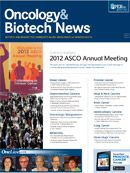Publication
Article
Oncology & Biotech News
Studies Support Efficacy of Axitinib as First- and Second-Line Kidney Cancer Treatment
Author(s):
Research presented at ASCO 2012 demonstrated the efficacy of axitinib (Inlyta) as both a first- and second-line treatment in patients with metastatic renal cell carcinoma.
M. Dror Michaelson, MD, PhD
Research presented at ASCO 2012 demonstrated the efficacy of axitinib (Inlyta) as both a first- and second-line treatment in patients with metastatic renal cell carcinoma (mRCC). Updated results of the phase III AXIS trial found that the benefit of second- line treatment for mRCC seen with axitinib at the first analysis of the study persisted with longerterm follow-up.1 Axitinib continued to show superiority to sorafenib (Nexavar) as second-line treatment for metastatic renal cell carcinoma (mRCC) in patients pretreated with cytokine therapy, as well as in other smaller subgroups.
For cytokine-treated patients, median progression-free survival (PFS) was 12 months with axitinib (n = 126 patients) versus 6.6 months with sorafenib (n = 125 patients). This difference was highly statistically significant (P <.0001), and represented a 48% reduction in the risk of disease progression in cytokine- treated patients who received axitinib (hazard ratio = 0.519; 95% CI, 0.375-0.720).
For patients treated with an interleukin-2— containing regimen, median PFS was 15.7 months with axitinib (n = 37 patients) versus 8.3 months with sorafenib (n = 38 patients). For those who received interferon-alfa alone, median PFS was 12.0 months with axitinib (n = 89 patients) versus 6.5 months with sorafenib (n = 87 patients).
Median overall survival (OS) in the cytokinetreated subgroup was 29.4 months with axitinib versus 27.8 months with sorafenib.
Adverse events for both drugs were similar in the two treatment arms. Adverse events reported in more than 25% of cytokine-treated patients who received axitinib included diarrhea (49.2%), hypertension (47.6%), fatigue (35.7%), dysphonia (29.4%), and hand-foot syndrome (28.6%).
“Updated results show a dramatic difference in PFS for axitinib versus sorafenib in the second-line setting in the population treated with cytokines. This study, as well as other studies, reflects the general efficacy of targeted therapy in metastatic renal cell carcinoma. Targeted therapies have altered the natural course of the disease, pushing survival further out to about 2.5 years,” stated lead author M. Dror Michaelson, MD, PhD, Massachusetts General Hospital Cancer Center in Boston.
Brian Rini, MD
Axitinib in First-Line Setting
In the first-line setting, a retrospective analysis of a randomized phase II trial found that axitinib achieved high response rates and median PFS >1 year.2 Lead author Brian I. Rini, MD, Cleveland Clinic Taussig Cancer Center, Ohio, emphasized that it appears that drug exposure and change in systolic blood pressure of ≥15 mmHg on cycle 1 day 15 are associated with better outcomes in patients receiving axitinib.
Previous studies have shown that patients treated with the 5-mg (twice daily) starting dose of axitinib exhibited variable levels of drug exposure. Higher drug exposure is associated with better clinical outcome. Rini said that the retrospective analysis was designed to assess whether dose titration in patients who tolerated the starting dose of axitinib had improved efficacy.
The study enrolled 213 patients with mRCC and clear-cell histology who had not been previously treated in the metastatic setting. Blood pressure at baseline could be <150/90 mmHg, and use of up to two antihypertensive agents was allowed. Patients received the starting dose of axitinib for 4 weeks, and those who met inclusion criteria were randomized to either dose titration or placebo titration of axitinib on a blinded basis.
Axitinib was effective in the first-line setting as shown by long PFS and high objective response rate, Rini said. Mean PFS in patients eligible for dose titration was 14.5 months and mean overall response rate was 43%.
Clinical parameters for dose titration based on individual tolerability were effective for identifying patients with subtherapeutic axitinib exposure on the 5-mg (twice daily) starting dose.
Patients who achieved higher drug exposure had a median PFS of 13.9 months and response rate of 59% versus 11 months and 40% in those with subtherapeutic exposure. Results were improved in a linear fashion with changes in systolic blood pressure on cycle 1 day 15.
Most common adverse events seen with axitinib included hypertension of all grades in 63% (grades 3 and 4, 29%), diarrhea of all grades in 58% (grades 3 and 4, 7%), fatigue of all grades in 48% (grades 3 and 4, 6%), and dysphonia of all grades in 40% (grades 3 and 4, 1%).
- Michaelson MD, Rini BI, Escudier BJ, et al. Phase III AXIS trial of axitinib versus sorafenib in metastatic renal cell carcinoma: Updated results among cytokine-treated patients. J Clin Oncol. 2012;30(suppl; abstr 4546).
- Rini BI, Grünwald V, Fishman MN, et al. Axitinib for firstline metastatic renal cell carcinoma (mRCC): Overall efficacy and pharmacokinetic (PK) analyses from a randomized phase II study. J Clin Oncol. 2012;30(suppl; abstr 4503).










